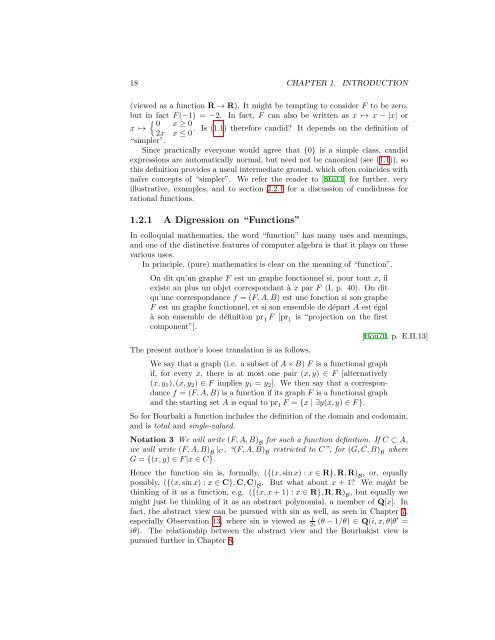Contents - Student subdomain for University of Bath
Contents - Student subdomain for University of Bath
Contents - Student subdomain for University of Bath
Create successful ePaper yourself
Turn your PDF publications into a flip-book with our unique Google optimized e-Paper software.
18 CHAPTER 1. INTRODUCTION<br />
(viewed as a function R → R). It might be tempting to consider F to be zero,<br />
but in<br />
{<br />
fact F (−1) = −2. In fact, F can also be written as x ↦→ x − |x| or<br />
0 x ≥ 0<br />
x ↦→<br />
. Is (1.1) there<strong>for</strong>e candid? It depends on the definition <strong>of</strong><br />
2x x ≤ 0<br />
“simpler”.<br />
Since practically everyone would agree that {0} is a simple class, candid<br />
expressions are automatically normal, but need not be canonical (see (1.1)), so<br />
this definition provides a useul intermediate ground, which <strong>of</strong>ten coïncides with<br />
naïve concepts <strong>of</strong> “simpler”. We refer the reader to [Sto11] <strong>for</strong> further, very<br />
illustrative, examples, and to section 2.2.1 <strong>for</strong> a discussion <strong>of</strong> candidness <strong>for</strong><br />
rational functions.<br />
1.2.1 A Digression on “Functions”<br />
In colloquial mathematics, the word “function” has many uses and meanings,<br />
and one <strong>of</strong> the distinctive features <strong>of</strong> computer algebra is that it plays on these<br />
various uses.<br />
In principle, (pure) mathematics is clear on the meaning <strong>of</strong> “function”.<br />
On dit qu’un graphe F est un graphe fonctionnel si, pour tout x, il<br />
existe au plus un objet correspondant à x par F (I, p. 40). On dit<br />
qu’une correspondance f = (F, A, B) est une fonction si son graphe<br />
F est un graphe fonctionnel, et si son ensemble de départ A est égal<br />
à son ensemble de définition pr 1 F [pr 1 is “projection on the first<br />
component”].<br />
[Bou70, p. E.II.13]<br />
The present author’s loose translation is as follows.<br />
We say that a graph (i.e. a subset <strong>of</strong> A × B) F is a functional graph<br />
if, <strong>for</strong> every x, there is at most one pair (x, y) ∈ F [alternatively<br />
(x, y 1 ), (x, y 2 ) ∈ F implies y 1 = y 2 ]. We then say that a correspondance<br />
f = (F, A, B) is a function if its graph F is a functional graph<br />
and the starting set A is equal to pr 1 F = {x | ∃y(x, y) ∈ F }.<br />
So <strong>for</strong> Bourbaki a function includes the definition <strong>of</strong> the domain and codomain,<br />
and is total and single-valued.<br />
Notation 3 We will write (F, A, B) B<br />
<strong>for</strong> such a function definition. If C ⊂ A,<br />
we will write (F, A, B) B<br />
| C , “(F, A, B) B<br />
restricted to C”, <strong>for</strong> (G, C, B) B<br />
where<br />
G = {(x, y) ∈ F |x ∈ C}.<br />
Hence the function sin is, <strong>for</strong>mally, ({(x, sin x) : x ∈ R}, R, R) B<br />
, or, equally<br />
possibly, ({(x, sin x) : x ∈ C}, C, C) B<br />
. But what about x + 1? We might be<br />
thinking <strong>of</strong> it as a function, e.g. ({(x, x + 1) : x ∈ R}, R, R) B<br />
, but equally we<br />
might just be thinking <strong>of</strong> it as an abstract polynomial, a member <strong>of</strong> Q[x]. In<br />
fact, the abstract view can be pursued with sin as well, as seen in Chapter 7,<br />
especially Observation 13, where sin is viewed as 1 2i (θ − 1/θ) ∈ Q(i, x, θ|θ′ =<br />
iθ). The relationship between the abstract view and the Bourbakist view is<br />
pursued further in Chapter 8.












![[Luyben] Process Mod.. - Student subdomain for University of Bath](https://img.yumpu.com/26471077/1/171x260/luyben-process-mod-student-subdomain-for-university-of-bath.jpg?quality=85)



